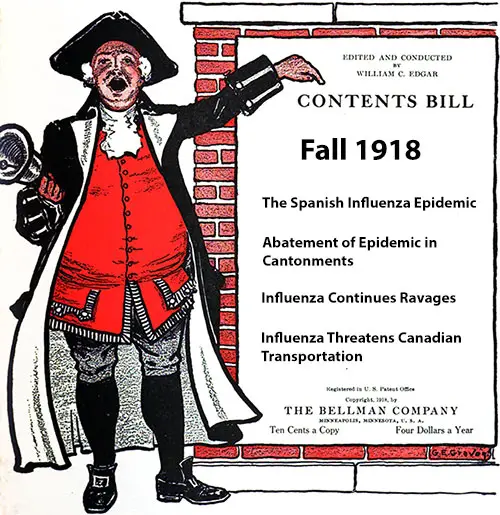The Growing Influenza Pandemic Reported by The Bellman - 1918

Before television and radio, the newspapers and magazines were tasked with spreading important news of the day. This is a series of news briefs on the Influenza Pandemic of 1918, as reported by a weekly news magazine called The Bellman of Minneapolis, Minnesota.
THE SPANISH INFLUENZA EPIDEMIC
Owing largely to the necessity of housing large numbers of men together in military training camps, the Spanish influenza, which became epidemic several weeks ago in Massachusetts, is now threatening to become a national disturbance.
Calls for the entrainment of one hundred and forty-two thousand draft registrants between October 7 and 11 have been canceled by Provost Marshal General Crowder, owing to serious conditions prevalent in many of the army camps.
The total number of cases in army camps is as high as seventy—five thousand, and rapidly increasing. Many cases develop pneumonia. Epidemics are reported from Montreal to Alabama, and as far west as Kansas. The civil population is suffering, as well as the men in camps.
Three thousand shipbuilders are listed among the cases in the Fore River yards at Quincy, Massachusetts. Bacteriologists claim to have isolated the bacillus which causes the trouble, and a new serum discovered at Tufts College is being tried out.
The Bellman, 5 October 1918, p. 374
ABATEMENT OF EPIDEMIC IN CANTONMENTS
Reports from the public health service in Washington show that influenza is continuing its ravages, and that the range of the epidemic has widened since last week. The malady is now prevalent all over the country and has reached epidemic form in eight southern states as well as in portions of the Middle West and Far West hitherto free from it.
In army camps, however, the daily number of new cases reported is said to be less, though several still report as many as a thousand cases a day. The total number of cases reported at army camps to October 8 was one hundred and eighty-two thousand.
The number of cases which have developed the so-called pneumonia is about ten per cent, while the death rate for all cases has reached approximately three percent.
Mobilization of the full forces of the American Red Cross has been determined upon to combat the further ravages of the disease, and instructions have been sent out to all chapters.
Surgeon General Blue, of the Public Health Service, has suggested to state health officers that all schools, public meetings and places of amusement be closed where the malady becomes prevalent, and several cities have already taken such measures.
The Bellman, 12 October 1918, p. 402
INFLUENZA CONTINUES RAVAGES
The influenza situation continues fairly discouraging, although somewhat better than last week. Scarcely any part of the country is escaping. New York City continues to report about four thousand new cases daily.
Massachusetts, which was the first state to be hit hard, now reports a steady decrease in the number of new cases and in deaths. From army camps comes a similar report of improvement.
It would seem that the disease tends to run a number of weeks in a community before it can be brought under control, though the public health service, which has now been organized for a nation-wide campaign, may find a quicker way out.
Methods employed thus far are entirely prophylactic. The etiology of the disease apparently remains undiscovered, though scientists in various parts of the world announce success. The postulated microorganism which causes influenza is generally held responsible for the so-called pneumonia as well.
The Bellman, 19 October 1918, p. 428+
INFLUENZA THREATENS CANADIAN TRANSPORTATION
According to the declaration of officials of the Canadian Railway War Board the first serious tie-up of Canadian railways during the war is threatened by the inroads of the influenza epidemic.
Almost one in every ten of the employees on the Canadian roads are said to be incapacitated. The railway authorities apparently have a considerable degree of confidence in the anti-influenza serum which is being supplied them by Toronto University, and which is being sent into the western provinces where the epidemic is now becoming more severe.
Voluntary inoculations are being offered to all railway workers free of charge. In Montreal there is a decided abatement of the epidemic.
The Bellman, 9 November 1918, p. 513
The Bellman, Published Weekly by The Bellman Company, Minneapolis, Minnesota. Their Motto: "It Tries to Tell the Truth."
Comment from the GG Archives: Considering that this was a weekly news magazine, their reporting on the pandemic was truly underwhelming in this case. What would you consider to be an appropriate level of reporting for a weekly news magazine of a significant health pandemic?
